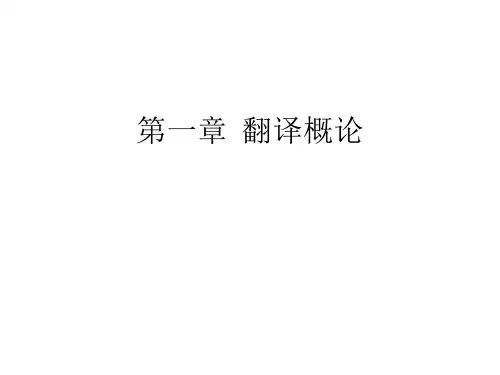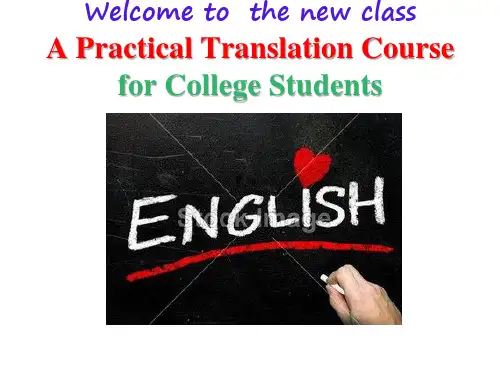大学实用翻译教程(英汉双向)第一章 翻译概述
- 格式:ppt
- 大小:673.50 KB
- 文档页数:3
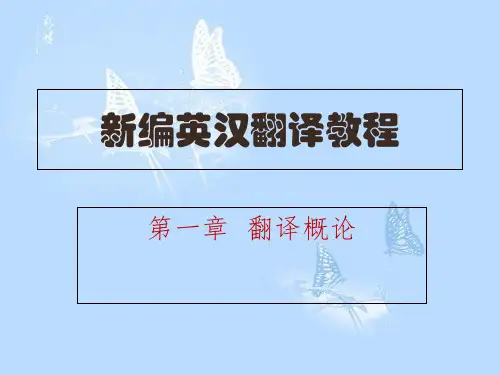
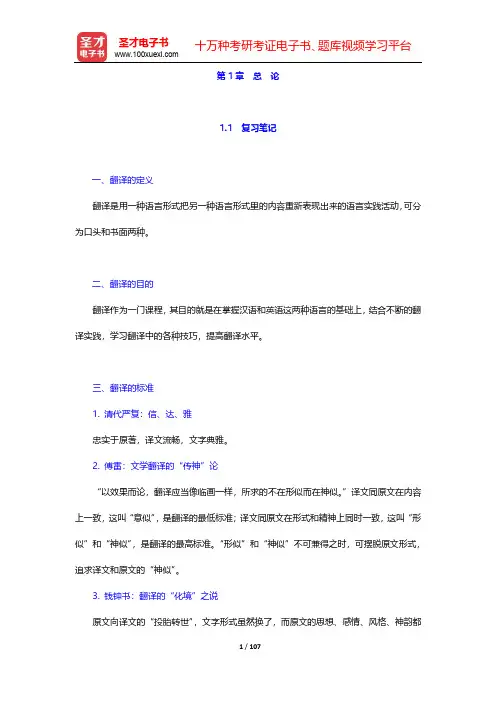
第1章总论1.1 复习笔记一、翻译的定义翻译是用一种语言形式把另一种语言形式里的内容重新表现出来的语言实践活动,可分为口头和书面两种。
二、翻译的目的翻译作为一门课程,其目的就是在掌握汉语和英语这两种语言的基础上,结合不断的翻译实践,学习翻译中的各种技巧,提高翻译水平。
三、翻译的标准1. 清代严复:信、达、雅忠实于原著,译文流畅,文字典雅。
2. 傅雷:文学翻译的“传神”论“以效果而论,翻译应当像临画一样,所求的不在形似而在神似。
”译文同原文在内容上一致,这叫“意似”,是翻译的最低标准;译文同原文在形式和精神上同时一致,这叫“形似”和“神似”,是翻译的最高标准。
“形似”和“神似”不可兼得之时,可摆脱原文形式,追求译文和原文的“神似”。
3. 钱钟书:翻译的“化境”之说原文向译文的“投胎转世”,文字形式虽然换了,而原文的思想、感情、风格、神韵都化到了译文的境界里,丝毫不留下翻译的痕迹,让读者读译作就像在读原作一样。
“化境”是比“传神”更高的翻译标准。
四、翻译的条件1. 汉语功底要好。
要学好汉语,一方面可借助于教材,掌握汉语语法,另一方面可读一些优秀的文学作品,学习地道的汉语表达方法。
2. 英语语言能力要强。
一方面要掌握全面的英语语法知识,另一方面要有很大的词汇量。
3. 知识面要广。
博览群书,增加自己的百科知识。
对于政治、经济、文化、等方面的知识都要有一定的了解。
第2章语义翻译2.1 复习笔记一、理解中的选义英语中的一词多义、汉语中的一字多义是常见的语言现象。
越是常用的字和词语,越是拥有繁多的释义和搭配,所以这就需要我们依靠具体的上下文来判断某一个字或词语的意义。
一字多义和一字多种搭配在汉语里也是相当常见的。
在进行翻译时,我们更多地要借助于上下文,从下文入手来理解字和词语。
有的时候,上下文不一定是完整的长句或一大段话,上下文可以是一个短短的词组或是一个紧凑的固定搭配。
也就是说,我们可以根据两三个字或词语来确定某一个字或词语的意义。
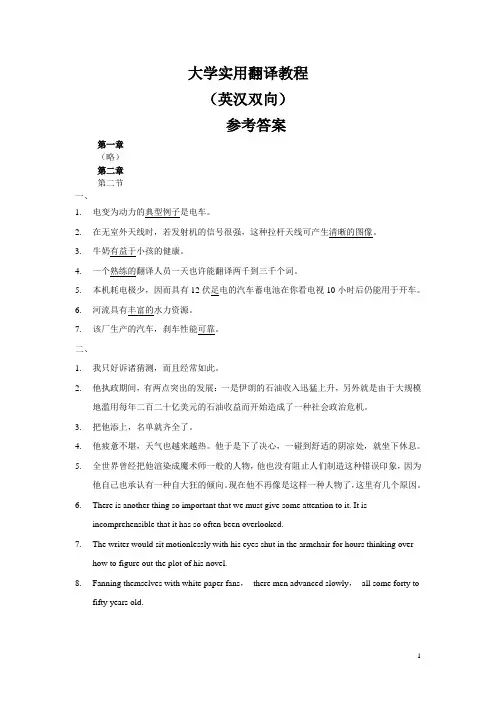
大学实用翻译教程(英汉双向)参考答案第一章(略)第二章第二节一、1.电变为动力的典型例子是电车。
2.在无室外天线时,若发射机的信号很强,这种拉杆天线可产生清晰的图像。
3.牛奶有益于小孩的健康。
4.一个熟练的翻译人员一天也许能翻译两千到三千个词。
5.本机耗电极少,因而具有12伏足电的汽车蓄电池在你看电视10小时后仍能用于开车。
6.河流具有丰富的水力资源。
7.该厂生产的汽车,刹车性能可靠。
二、1.我只好诉诸猜测,而且经常如此。
2.他执政期间,有两点突出的发展:一是伊朗的石油收入迅猛上升,另外就是由于大规模地滥用每年二百二十亿美元的石油收益而开始造成了一种社会政治危机。
3.把他添上,名单就齐全了。
4.他疲惫不堪,天气也越来越热。
他于是下了决心,一碰到舒适的阴凉处,就坐下休息。
5.全世界曾经把他渲染成魔术师一般的人物,他也没有阻止人们制造这种错误印象,因为他自己也承认有一种自大狂的倾向。
现在他不再像是这样一种人物了,这里有几个原因。
6.There is another thing so important that we must give some attention to it. It isincomprehensible that it has so often been overlooked.7.The writer would sit motionlessly with his eyes shut in the armchair for hours thinking overhow to figure out the plot of his novel.8.Fanning themselves with white paper fans,there men advanced slowly,all some forty tofifty years old.9.We are certain that joint efforts to strengthen all forms of economic and trade cooperation onthe basis of equality and mutual benefit will lead to wide prospects for the development of mutual trade relations.10.All citizens who have reached the age of eighteen have the right to vote and to stand forelection,with the exception of persons deprived of these rights by law.第四节一、略二、1. 当时是八月中旬。

![大学英语翻译全教程第一讲(完美版)[范文大全]](https://uimg.taocdn.com/e5ef493015791711cc7931b765ce050877327575.webp)
大学英语翻译全教程第一讲(完美版)[范文大全]第一篇:大学英语翻译全教程第一讲(完美版)翻译理论与实践(以《英语翻译教程》南开大学出版社为基础)第一讲翻译概述一、翻译的概念1.广义的翻译指语言与语言、语言与非语言等代码转换和基本信息的传达。
它包括不同语言间的翻译(如英汉互译)语言变体间的翻译(如古今语言、不同方言的互译)、语言与其他交际符号的转换(如把交通规则画成交通标志)。
他对翻译的内容只强调“基本信息”,不强调“完全的忠实”。
也有翻译家提出“理解也是翻译”的理论,这就把语言与思维也包括在广义的翻译里了。
2.狭义的翻译指语言活动,是把一种语言所表达的内容中式地用另一种远表达出来。
这个定义强调“是一种语言活动”,表明它是人类多种交际方式中语言交际的沟通;强调“一种语言到另一种语言”,排除了同一语言间各变体的互译;强调“忠实地”,避免了翻译与释义或改写的混淆。
奈达(Eugene Nida)“Translation consists in reproducing in the receptor language the closest natural equivalent of the source-language message, first in terms of meaning and second in terms of style.”(Nida & Taber: Th e Theory and Practice of Translation)我们的翻译课讲的就是狭义的翻译,并专指“书面表达内容”,以区别于有独特之处的口译(interpretation)。
二、翻译的分类1.从所涉及的代码性质看,可分为语内翻译(intralingual translation)、语际翻译(interlingual translation)和语符翻译(intersemiotic translation)。
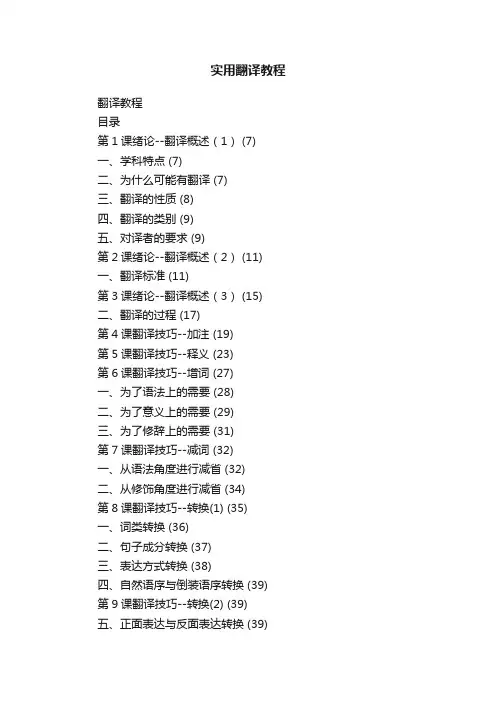
实用翻译教程翻译教程目录第1课绪论--翻译概述(1) (7)一、学科特点 (7)二、为什么可能有翻译 (7)三、翻译的性质 (8)四、翻译的类别 (9)五、对译者的要求 (9)第2课绪论--翻译概述(2) (11) 一、翻译标准 (11)第3课绪论--翻译概述(3) (15) 二、翻译的过程 (17)第4课翻译技巧--加注 (19)第5课翻译技巧--释义 (23)第6课翻译技巧--增词 (27)一、为了语法上的需要 (28)二、为了意义上的需要 (29)三、为了修辞上的需要 (31)第7课翻译技巧--减词 (32)一、从语法角度进行减省 (32)二、从修饰角度进行减省 (34)第8课翻译技巧--转换(1) (35)一、词类转换 (36)二、句子成分转换 (37)三、表达方式转换 (38)四、自然语序与倒装语序转换 (39) 第9课翻译技巧--转换(2) (39)五、正面表达与反面表达转换 (39)六、主动式与被动式转换 (41)七、分句转换 (42)第10课翻译技巧--归化 (43)第11课翻译技巧--切分与合并 (46)一、切分 (46)二、合并 (50)第12课翻译层次--词语层 (51)一、词语层 (51)二、选词用字 (54)第13课翻译层次--句子层 (55)一、英汉句子对比 (56)二、英语句子翻译 (57)第14课翻译层次--段落与篇章 (60)一、段落(paragraph) (60)二、篇章 (62)第15课翻译难点--声色词的译法(1) (64)一、英汉拟声词比较 (64)二、拟声词译法 (65)第16课翻译难点--声色词的译法(2) (68)一、英汉颜色词比较 (68)二、颜色词的译法 (70)第17课翻译难点--习语译法(1) (72)一、英汉习语比较 (73)二、英语习语的译法 (75)第18课翻译难点--习语译法(2) (77)第19课翻译难点--名称译法(1) (81)一、英语人名的译法 (81)二、书名、影视片名的译法 (83)三、报刊杂志名的译法 (84)第20课翻译难点--名称译法(2) (85)四、地名的译法 (85)五、机构名称的汉译 (87)六、商标的译法 (87)第21课翻译难点--英语修辞格译法(1) (89) 一、什么是修辞格 (90)第22课翻译难点--英语修辞格译法(2) (94) 二、修辞格的译法 (94)第23课翻译疑点--动与静 (98)一、动与静 (99)第24课翻译疑点--概略化与具体化 (102)一、概略化 (103)二、具体化 (104)第25课翻译疑点--有灵动词与无灵动词 (107)一、英语无生命主语句特点 (107)二、无生命主语句的译法 (108)第26课翻译疑点--形合法和意合法 (111)一、采用意合法 (112)二、采用形合法 (114)第27课翻译与文体--应用文翻译 (116)一、公文的文体特点及翻译 (116)二、商贸函电的文体特点及翻译 (117)三、广告英语的文体特点及翻译 (119)第28课翻译与文体--论说文翻译 (120)第29课翻译与文体--新闻英语翻译 (124)第30课翻译与文体--科技英语翻译 (129)一、科技英语的文体特点 (129)二、科技英语的翻译 (131)第31课翻译与文体--文学翻译(1) (134)一、小说的翻译 (134)二、散文的翻译 (137)第32课翻译与文体--文学翻译(2) (138)一、诗歌的翻译 (138)二、舞台剧及影视剧本的翻译 (142)第33课翻译批评--翻译批评原则 (144)一、什么是翻译批评? (144)二、翻译批评的原则 (145)第34课翻译批评--翻译批评的方法和步骤 (148)一、翻译批评的方法 (148)二、翻译批评的步骤 (149)三、翻译批评应注意的几个问题 (150)第35课翻译史--中国翻译简史 (151)一、汉代-秦符时期 (152)二、隋-唐-宋时代 (153)三、明清时代 (154)四、五四时期 (156)五、新中国成立至今 (157)第36课翻译史--西方翻译简史 (157)一、西方翻译活动简介 (158)二、西方译论简介 (160)。
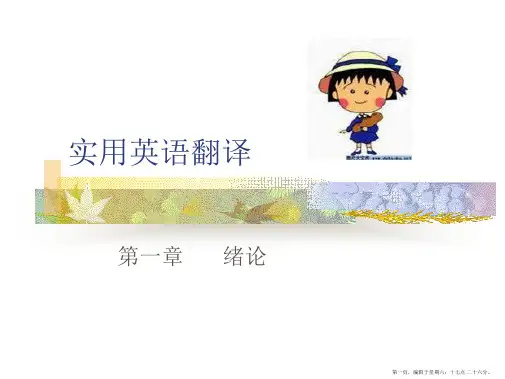

大学英语实用翻译译史译论译作并重经验科学中西合璧-----林克难导学第一单元翻译原则忠实通顺第二单元分清主次理顺关系第三单元选词用字三个依据第四单元直译意译传神达意第五单元词类转换流畅自然第六单元适当增添清楚明了第七单元词语省略言简意赅第八单元小小代词不可轻视第九单元结构调整顺理成章导学Aims: t o know the significance of translation, requirements and allotment of this course and also to know how to learn translationContents:Course description and requirementsAllotmentQualificationsGuidelinesReferences and websitesExercisesA ssignmentCourse descriptionThis course named “college English translation” aims at cultivating the SS’ ability of translation between English and Chinese. They have the ability to understand and master some basic theories and techniques about translation. E.g. the brief history of Chinese and western translation theories, the differences between E-C, the eight basic techniques in translation, some methods to deal the special sentences, etc. In a word, the SS will have the first impression to English language and Chinese language, and through these discussions they will have a higher ability in their English proficiency.To pass this course, ss must attain at average of 60% in the following categories: Participating: 10%participating is vital to the learning process and it includes attendances, being on times, coming to class prepared, interacting with other S s, and participating in class discussions. SS who are frequently absent, tardy, or refuse to participate will receive a poor participation grade. Note: there are NO excused absences. Any absences or tardy will result in a lower participation grade.Homework:20%SS will have to complete periodic homework assignments related to this course (includingreviewing and previewing the text, etc). The teacher may give homework/assignments on each topic discussed in the class if there is a need.Te s ts:70%There will be only one test: a final. But they may also be several short quizzes through the term.•Attendance:Daily attendance will be recorded.•Classroom Policies:late work: assignments must be turned in on the due date for full credit. Unless otherwise indicated, all assignments will be due at the beginning of the class period.Copy and plagiarism:SS should do their own work in order to maximize learning. Collaborating on assignments is permitted, but copying another student’s work is prohibited. Similarly, ss who are caught copying or plagiarizing will fail the assignment.Allotment:•导学第一单元翻译原则忠实通顺 2学时第二单元分清主次理顺关系 2学时第三单元选词用字三个依据 2学时第四单元直译意译传神达意 2学时第五单元词类转换流畅自然 2学时第六单元适当增添清楚明了 2学时第七单元词语省略言简意赅 2学时第八单元小小代词不可轻视 2学时第九单元结构调整顺理成章 2学时Qualifications:Translation, no matter what sort of translation it may be, surely serves as an inter-medium between two different languages, between the peoples of two countries, just like E--C translation as a medium between English and Chinese. So here are some necessary qualifications which translators must have.• A translator must be well acquainted with the source language• A translator must be well acquainted with the target language• A translator must be armed with professional knowledge needed• A translator must be armed with the ability to feel empathy for the SL writer and the characters portrayed. That is to say, he seems to be:(1)Present at the very spot(身临其境)(2)Involved in the very occurrence(亲历其事)(3)witnessing the very parties concerned(亲睹其人)(4)Iterating the very utterances(亲道其法)(5)Experiencing the very joy.(亲尝其甘)(6)And sorrow(亲领其苦)(7)Sharing the very weal(亲享其福)(8)And woe(亲受其祸)(9)Partaking of the glee(亲得其乐)(10) And grief(亲感其悲)• A translator must be armed with the excellent ability of expressiveness and imagination.•译者的素养:外语素质母语素质语言敏感度百科能力心理素质政治素质辅助工具:工具书百度电子词典在线在线词典。
